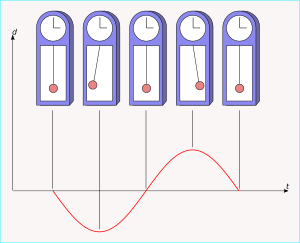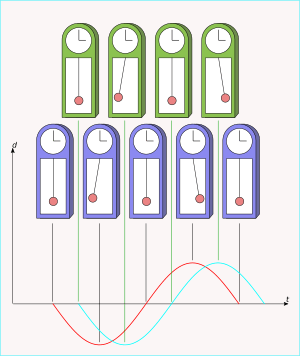Phase facts for kids
A phase is one part of a cycle or change that happens over time. Think of it like a stage in a repeating pattern. Many things in nature and science go through different phases. These changes often happen in a regular, predictable way.
Contents
Understanding Phases in Cycles
A phase is a specific point or stage in a repeating process. Imagine a circle: as you move around it, you pass through different points. Each of these points can be thought of as a phase.
Moon Phases: A Familiar Example
The moon is a great example of something that has phases. As the Moon orbits the Sun, we see different amounts of its lit-up surface from Earth. This creates the familiar moon phases we see every month.
These phases include the new moon, crescent, quarter, gibbous, and full moon. They repeat in a cycle that takes about 29.5 days.
Planetary Phases: Venus's Story
Did you know that planets can also have phases? The planet Venus shows phases, just like our Moon. This was a very important discovery made by Galileo a long time ago. Seeing Venus go through phases helped prove that planets orbit the Sun, not the Earth. This was a big step in understanding our Solar System.
Seasons: Earth's Yearly Phases
The seasons of the year are also phases. Spring, summer, fall (or autumn), and winter are stages in Earth's yearly journey around the Sun. Each season brings different weather and changes in nature. This cycle repeats every year.
Phases in Motion and Vibrations
In science, especially in physics, phases can describe how things move or vibrate. When something moves back and forth in a regular way, like a swing or a pendulum, it goes through different phases of its motion.
Pendulum Phases: In and Out of Sync
Imagine a pendulum swinging in a clock. It moves from one side, through the middle, and to the other side. This is one full cycle of its motion.
If you have two pendulums, they might have the same length and swing at the same speed. But if they don't start swinging at the exact same moment, they won't move together. One might be swinging left while the other swings right. When this happens, the two pendulums are "not in phase" with each other. They are "out of sync."
When things are "in phase," they are moving or vibrating together at the same time and in the same way. When they are "out of phase," their movements are not aligned. This idea of "in phase" and "out of phase" is important in understanding waves, like sound waves or light waves.
See also
 In Spanish: Fase para niños
In Spanish: Fase para niños




